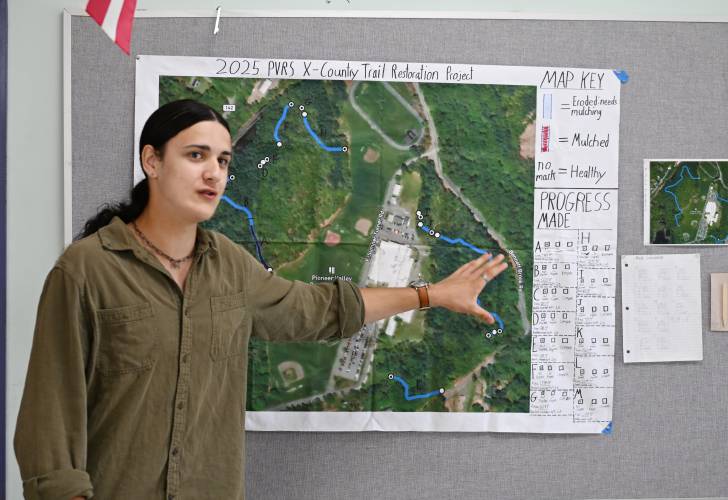
Pioneer’s Innovation Career Pathways environmental science program shows results
How did your country report this? Share your view in the comments.
Diverging Reports Breakdown
Pioneer’s Innovation Career Pathways environmental science program shows results
Pioneer Valley Regional School’s Innovation Career Pathways program is in its first year. The program’s first five seniors undertook capstone projects or internships to put their curriculum to work. Lex Singh helped address erosion on the school’s cross-country trail. Liz Brown completed an internship with the U.S. Geological Survey Eastern Ecological Science Center in Turners Falls, and Jerad Goulston Jr. designed, built and coded an indoor plant growing system.“The students had these amazing ideas and the school supported them to do really cool stuff,” said Environmental Pathway Coordinator Heather Berlin, who joined the school in March.ships provide students with work-based, applied learning experiences in high-demand industries, such as advanced manufacturing, information technology, health care, and environmental and life sciences, Berlin said. It follows up on work by Pioneer alum Cooper Bullock, who started a land stewardship club in 2023, and Bernardston resident John Lepore, who published a book.
Over the last several months, the program’s first five seniors undertook capstone projects or internships to put their curriculum to work, with each student’s work providing some benefit to the school or Franklin County at large. The work, as well as the program, continues the district’s push to include more education focusing on the area’s natural resources, including at Pioneer and both elementary schools.
In finishing out their high school careers, Natalie Johnson helped revitalize the school’s courtyard with a greenhouse and plant boxes, Lex Singh helped address erosion on the cross-country trail and Amelia Fowler-Shaw finished up a stint with the Franklin Land Trust, where she helped the organization complete its annual compliance monitoring and surveys of natural resources.
Also among the inaugural environmental science class were Liz Brown, who completed an internship with the U.S. Geological Survey Eastern Ecological Science Center in Turners Falls, and Jerad Goulston Jr., who designed, built and coded an indoor plant growing system featuring automated lighting and watering.
“The students had these amazing ideas and the school supported them to do really cool stuff. … I came in and was blown away by how creative and independent they were,” said Environmental Pathway Coordinator Heather Berlin, who joined Pioneer in March. “It’s really nice to see so many authentic learning opportunities.”
The Innovation Career Pathways program, funded by a $75,000 state grant, allows students to participate in work-based, applied learning experiences in high-demand industries, such as advanced manufacturing, information technology, health care, and environmental and life sciences. Through the program, schools also partner with local businesses to provide hands-on internships within the community, which in turn provide students with the most authentic look possible at their chosen industry.
For Johnson, the program presented an opportunity to make use of the school’s greenhouse, which had been sitting vacant in a different part of the school grounds. On top of making use of the greenhouse, she also enlisted the school’s woodshop class to create plant beds, which now feature tomatoes, cosmos and other native plants.
“I knew it was sitting out back and I was like, ‘Why is it not being used?’ Then my ideas kept growing,” she said. “Planting the plants not only makes the school more beautiful, but it also helps the environment.”
Singh, a longtime member of the school’s cross-country team, decided to take their passion for running and apply it to the school’s 2.79-mile course. To do so, Singh surveyed the trail — and even found the 2-mile marker was in the incorrect place — and marked areas where either tree roots were exposed, there was a tripping hazard for runners or erosion was present. Preventing erosion, Singh said, stops sediment from building up, which protects the forest’s health.
“Our trail is just roots. Somebody trips every time we have a meet,” Singh said, adding that they and others have already mulched between 450 and 500 feet of the 0.93 miles that need it. In total, they expect to need 4,029 cubic feet of mulch to finish the improvements. “By covering the roots, we’re reviving the forest’s ability to maintain itself.”
This follows up on work by Pioneer alum Cooper Bullock, who started a land stewardship club in 2023, and Bernardston resident John Lepore, who published a book about the school’s land stewardship.
Fowler-Shaw, who completed a 102-hour internship with the Franklin Land Trust, said she was tasked with visiting the nonprofit’s conserved land, monitoring the sites’ quality and creating reports. In total, she visited 35 different properties, which taught her not only how the organization works, but supplied her with hands-on experience in connecting with landowners, filling out official databases and other professional skills.
“I learned a lot about how land conservation works in the real world,” Fowler-Shaw explained. “It was a really cool experience.”
Berlin added that those professional skills, as well as “soft skills,” like time management or helping advise a student-led project, are “embedded” in the Innovation Career Pathways program.
The students also said these opportunities provided them with life lessons.
“If you want something to improve,” Singh said, “you’ve got to take action yourself.”
For more information about Pioneer’s Innovation Career Pathways environmental science program, visit bit.ly/4mTvoPz.
Chris Larabee can be reached at clarabee@recorder.com.
